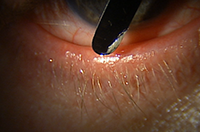| |
|
| Vol. 2, #05 • Thursday, April 15, 2021 |
|
|
|
|
| |
|
Review's Chief Clinical Editor
Paul M. Karpecki, OD, FAAO
Provides you with cutting-edge clinical strategies for optimal management of ocular surface disease and beyond.
|
|
|
|
|
|
 |
| Lid margin debridement. |
|
To differentiate and bolster your dry eye practice, consider offering in-office procedures.
One important lesson from the COVID shutdowns was that optometry practices that performed in-office procedures and included a medical eye care focus did far better than practices that only offered glasses and contact lenses. Perhaps because of the sudden shift of the workforce to increased hours on digital devices, a number of patients noticed how uncomfortable their dry eye, MGD, or blepharitis was and wanted immediate relief. Many of our patients, who had saved money during the shutdown or received stimulus checks, put some of the proceeds toward in-office treatments for OSD.
What tools are needed to expand into in-office procedures? That depends on your financial situation and the level of differentiation you want to achieve, but I would consider the following key items:
1. Eyelid debrider (Bruder). Eyelid debridement provides a quick and positive result for the patient following every dry eye exam. It takes about 20 seconds to debride the lower eyelids, and patients are amazed at how good their eyes feel afterward. Unfortunately, no CPT code exists for reimbursement and no patient pay option is available here, but the process takes less than 30 seconds, and you may just make a patient for life. There is no need to anesthetize the eye since the process is comfortable, and an anesthetic would negate the immediate, positive response.
2. Microblepharoexfoliation (MBE, BlephEx). This patient-pay procedure debrides the eyelid margin, removes biofilm, and cleans the lashes from bacteria and/or demodex. Topical anesthetic is necessary to help keep the patient from closing their eyes during the process. A foam cleanser is designed for the BlephEx instrument, and cleaning the eyelids takes just a few minutes per eye. Following this procedure, many patients have commented to me that their eyes “haven’t felt this good in decades.”
3. Thermal expression. A wide range of options are available to improve meibomian gland function, including the LipiFlow Thermal Pulsation System, iLux device, TearCare tool, Thermal 1-Touch, IPL (intense pulsed light), and LLLT (low-level light therapy). Future clinical pearls will describe the major differences, but suffice it to say that these treatments greatly help MGD and evaporative DED patients.
Following any MBE or thermal expression procedure, certain patients benefit from a topical corticosteroid such as EYSUVIS, which is FDA approved for the short-term (up to two weeks) treatment of dry eye signs and symptoms.
If we were to equate the model of dental care to eyecare, toothbrushing and flossing would be equivalent to lid scrubs and hydrating compresses (plus omega fatty acid supplements when inflammation is present). Just as patients routinely visit the dentist for in-office cleaning/treatments followed by at-home maintenance, they can follow a similar regimen at the dry eye practice.
|
|
|
|
KEY TAKEAWAY: Consider in-office procedures to differentiate your practice and to provide effective patient treatment options for various forms of ocular surface disease.
|
|
|
|
| Supported by an independent medical grant from Kala Pharmaceuticals |
|
| |
| |
Review of Optometry® is published by the Review Group, a Division of Jobson Medical Information LLC (JMI), 19 Campus Boulevard, Newtown Square, PA 19073.
To subscribe to other JMI newsletters or to manage your subscription, click here.
To change your email address, reply to this email. Write "change of address" in the subject line. Make sure to provide us with your old and new address.
To ensure delivery, please be sure to add revoptom@lists.jobsonmail.com to your address book or safe senders list.
Click here if you do not want to receive future emails from Review of Optometry. |
|
|
|
|
|
|
|
|